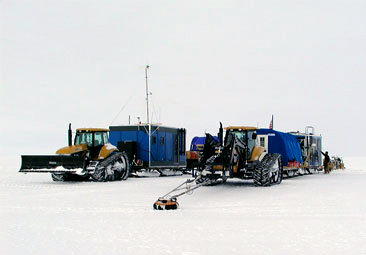|
Tropical connectionITASE data used to link El Niño and West Antarctic climatePosted October 17, 2008
As the tropics go, so goes West Antarctica. That’s the conclusion from scientists who analyzed ice cores recovered by the U.S. component of the International Trans-Antarctic Scientific Expedition (ITASE) A paper, first published in the online version of the Proceedings of the National Academy of Sciences in August, found that atmospheric and ocean patterns in the tropics, particularly El Niño “The connection between El Niño and Antarctica has been talked about, but it’s always been elusive. We’ve kind of taken this fuzzy link and pinned it down, at least for this one specific episode in the 1940s,” explained David Schneider The overall trend across the last century has been warming — about 1.6 degrees Celsius in West Antarctica — as the Pacific Ocean heated. “It’s likely this connection will continue in the future,” Schneider said. “The warming in the equatorial western Pacific is particularly effective at causing these connections to high latitudes.” Scientists are especially interested in West Antarctica because of its possible effect on sea level as it loses ice. Various estimates say seas could rise by as much as five meters should the ice sheet and its glaciers entirely disintegrate. Schneider and co-author Eric Steig Representing anywhere from 100 to 300 years, the cores provide what scientists call a “high-resolution” record of past climate, an annual history of temperature. By comparing different stable isotopes of oxygen Using this method, Schneider and Steig determined that during an unusually strong El Niño event from 1939 to 1942, temperatures in West Antarctica rose by about 3 to 6 degrees Celsius and then dropped by an estimated 5 to 7 degrees over the next two years. El Niño is a periodic oceanic warming in the tropical Pacific accompanied by shifts in air pressure. A natural phenomenon, El Niño’s intensity or frequency may be affected by ongoing climate change, which in turn would influence climate in West Antarctica. “When we got all of the ice core data together, we noticed a big anomaly in the 1940s,” Schneider said. “[It’s] really significant compared to the rest of the record in the last 100 to 150 years.” In a previous statement, Steig said that while the influence of the tropics on West Antarctica climate was not unknown, “these results are the first to demonstrate that we can unambiguously detect that influence in ice core records.” The El Niño influence appears to be confined to West Antarctica and not its higher and colder counterpart across the Transantarctic Mountains, East Antarctica. The cores, Schneider noted, were drilled at an elevation between about 1,000 and 1,800 meters. East Antarctica is generally much higher. “It’s a little bit more likely that changes in the atmospheric circulation will affect West Antarctica relatively more than East Antarctica,” he said. “It’s down lower where we’re seeing more changes.” Despite the long-term warming and variable climatic spikes, there is no strong evidence that there’s been any additional precipitation in West Antarctica, according to Schneider. That’s important to understand for scientists who want to know whether the marine-based ice sheet is in balance — whether its ice loss at the edges is being offset by snowfall in the interior. One would expect to see more precipitation, Schneider agreed, but it’s unclear where it might occur. Perhaps the storms are happening off shore. “I don’t think we know yet where the precipitation will increase,” he said. This is one of several papers to interpret the data from ITASE, which is led by principal investigator Paul Mayewski U.S. ITASE scientists have made six traverses across parts of the continent since 1999 — four in West Antarctica and two in East Antarctica — collecting more than 40 ice cores. Twenty-one nations now comprise ITASE, many of them conducting their own overland journeys as they cooperatively build a database about Antarctica’s climate for the last millennium, particularly the last two centuries of the human industrial age. Schneider said one of the accomplishments of the ITASE program was venturing into areas without prior meteorological data. “It’s a really important area for understanding how the climate system behaves and is likely to behave in the future,” he said. “I think these data are really important for putting all of the pieces together.” NSF-funded research in this story: Eric Steig, University of Washington, Award No. 0440414 |
"News about the USAP, the Ice, and the People"



For USAP Participants |
For The Public |
For Researchers and EducatorsContact UsNational Science FoundationOffice of Polar Programs Geosciences Directorate 2415 Eisenhower Avenue, Suite W7100 Alexandria, VA 22314 Sign up for the NSF Office of Polar Programs newsletter and events. Feedback Form |



